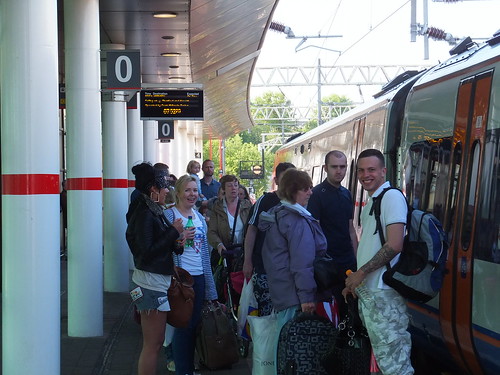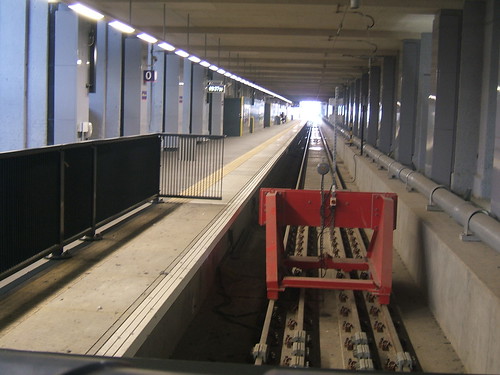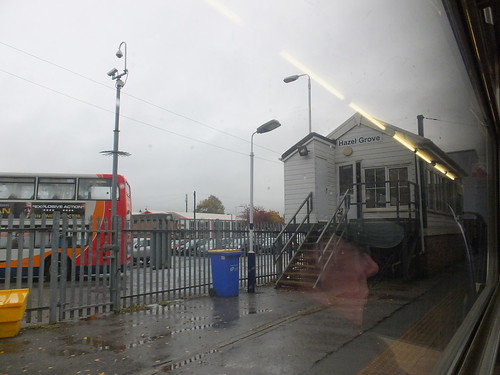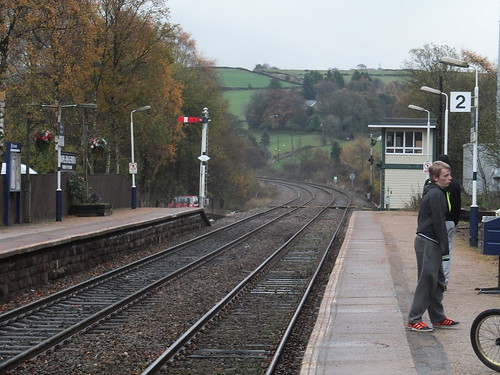Stockport
Stockport area is interesting in that it has retained five signalboxes on the main line to Piccadilly. From the north, Heaton Norris Jn. (controlling the branch to Guide Bridge), Stockport No. 2, Stockport No. 1, Edgeley Jn. No. 2 (controlling the branch to Northeenden Jn. and Altrincham) and Edgeley Jn. No. 1 (controlling the double track branch to Buxton). Stockport Station has another claim to fame - it has a Platform 0.
 Platform 0 at Stockport.
Platform 0 at Stockport.
I mentioned Stockport's Platform 0 in the earlier post Platform Numbering Revisited. At the time, Cardiff and Haymarket also had a Platform 0. I added that I'd been 'reliably informed' that the new platform at King's Cross would become Platform Y, rather than Platform 0. So much for 'reliable informants' - the new platform at the rebuilt King's Cross subsequently became Britain's fourth Platform 0!
 Platform 0 at King's Cross.
Platform 0 at King's Cross.
DMU to Dove Holes
My train to Dove Holes was a Northern Rail service from Manchester Piccadilly to Buxton, operated by a 2-car Class 156 which arrived about three minutes late. Colour light signals beckoned us onto the Buxton Branch and we made brief stops at Davenport (where I caught a glimpse of the L&NWR access steps leading down from an L&NWR station building) and Woodsmoor, before arriving at Hazel Grove.
The line is electrified at 25 kV a.c. as far as Hazel Grove so the DMU service to and from Buxton is augmented by EMUs which terminate here. Fairly modern station buildings are provided, but I was more interested in the L&NWR signal box on the Up platform, thoroughly modernised with uPVC double glazed window units replacing the original (draughty) L&NWR casements.
 Hazel Grove Signal Box.
Hazel Grove Signal Box.
The box controls two stock sidings and two crossovers allowing electric trains to arrive and depart from either through platform. Beyond the station, the single line Hazel Grove Chord gives access to the former Midland Hope Valley Line to Sheffield. Our double track route now started a climb into the hills at 1 in 60 and the noise from the underfloor engines became quite loud.
 Gradient Diagram: Stockport - Buxton (HMSO).
Gradient Diagram: Stockport - Buxton (HMSO).Click here for larger view.
Colour light signals were now left behind - I think the first semaphores were a distant and home protecting the level crossing at Norbury Hollow where there's a charming Gate Box.
I was surprised that we didn't stop at Middlewood station. Although there's one train an hour each way to Buxton, I discovered later that alternate trains don't stop at Middlewood (or Dove Holes). In the pouring rain, we stopped at Disley where the gradient became downhill through New Mills Newtown (so called to distinguish it from New Mills Central on the former Midland line which was just visible through the rain across the valley).
Furness Vale retains its L&NWR signal box (modernised, of course) and controls a level crossing with four lifting barriers.
 Furness Vale Signal Box.
Furness Vale Signal Box.
Entering the next station, Whaley Bridge, I spotted the Jodrell Arms Hotel which I visited some years ago when The Old Locomotive Committee held an A.G.M. there. The gradient became 1 in 60 to Chapel-en-le-Frith, easing to 1 in 150 through the platforms (steep gradients are avoided wherever possible through platforms). where the station name boards make the twin claims of being "The Home of Ferodo" and "The Capital of the Peak".
The Chapel-en-le-Frith Accident
Chapel-en-le-Frith was the site of the very tragic accident in 1957 when a Class 8 suffered a brake failure caused by a steam pipe joint giving way, filling the cab with scalding steam. The train careered downhill with its train, colliding with a previous freight train at Chapel-en-le-Frith. The driver and fireman were commended for their bravery. Driver John Axon remained on the locomotive and was killed in the collision, being posthumously awarded the George Cross. The Railway Archive has a summary of the accident and the subsequent accident report is available here. In 1958, the BBC produced 'The Ballad of John Axon', in an innovative fusing of Ewan MacColl's ballads with location recordings including interviews with real railwaymen, briefly described here. I still find 'The Ballad of John Axon' very moving - it's available in various forms like CD, mp3 and printed word.
DMU to Dove Holes (continued)
Leaving Chapel-en-le-Frith, we passed the BR standard design signal box on the Down side - a permanent reminder of the 1957 accident which demolished the original L&NWR signal box on the Up side. The gradient reverted to 1 in 58 to my destination, Dove Holes. Again, there was an easing to 1 in 150 through the platforms. In the pouring rain, I alighted and watched the DMU depart for Buxton, climbing at 1 in 70 to the summit.
DMU back to Stockport
When I was ready to start my return journey, I discovered that a Stockport train was due through Dove Holes fairly soon. Unfortunately, it was one of the trains not booked to stop. My friends kindly took me by road to Chapel-en the-Frith where I was able to pick up the train, rather than wait over an hour for the next train stopping at Dove Holes. The weather had improved and the journey back to Stockport was uneventful. With unexpected good luck, on arrival at Stockport I just had time to hurry through the subway to platform 2 and board a waiting Cross Country 'Voyager' back to Wolverhampton.
 Chapel-en-le-Frith station, looking towards Buxton, showing the site of the 1957 collision. The replacement signal box built after the collision is on the right.
Chapel-en-le-Frith station, looking towards Buxton, showing the site of the 1957 collision. The replacement signal box built after the collision is on the right.
Railway Maps
You can find detailed signal box diagrams for the route back in steam days in the excellent series of publications from the Signalling Record Society 'British Railways Layout Plans of the 1950's' - 'Volume 15: ex-LNWR lines Crewe (excl) to Manchester & Leeds, and branches' (ISBN: 1 873228 11 2).
If you want to see what remains of the route, refer to 'Railway Track Diagrams Book 4: Midlands & North West', Second Edition (or later), published by Trackmaps (ISBN: 1-9549866-0-1).
My photographs
Buxton Branch.
Manchester Area Rail.
